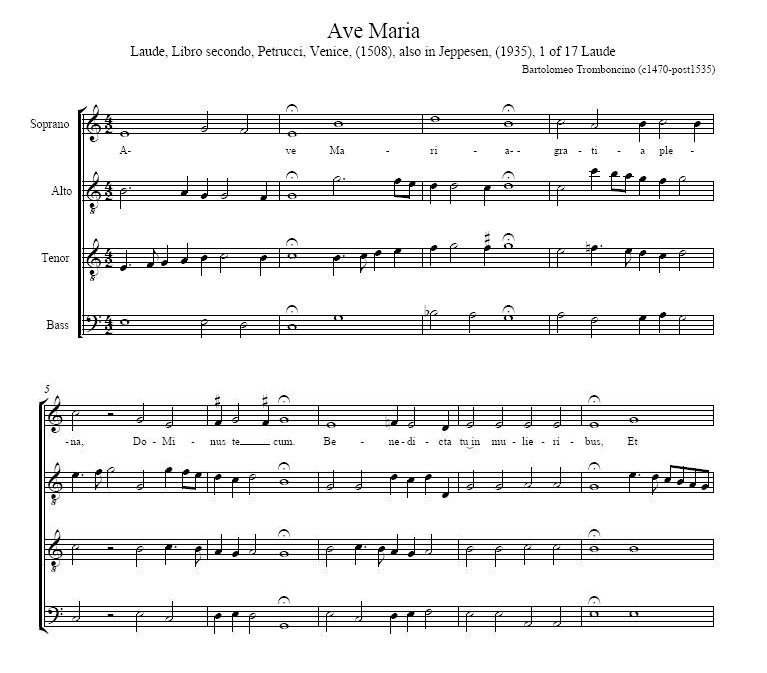Ave Maria #40
Composer: Bartolomeo Tromboncino (c1470-c1535), 1508


| Lyrics: not available, see
score. |
|
| Score: free download on
IMSLP
transcribed by Martin Grayson |
|
play/stop MIDI:

|


| Internet
references, biography information. |
|
http://en.wikipedia.org/wiki/Bartolomeo_Tromboncino |
|
Bartolomeo Tromboncino (c. 1470 –
1535 or later) was an Italian composer of the middle Renaissance. He is
mainly famous as a composer of frottola; he is principally infamous for
murdering his wife. He was born in Verona and died in or near Venice.
Life
Details of his early life are sketchy, as is common for most composers of
the time, but most likely he grew up in Mantua, and he mentions in a letter
that he was originally from Verona. Until around 1500 he lived and worked in
Mantua, though he made occasional trips to adjacent cities such as Ferrara,
Este, Vicenza, Milan, and Pavia, especially when he was in trouble. He fled
the city in 1495 for unknown reasons, returning later that same year; in
1499 he murdered his wife when he discovered her in flagrante delicto but,
unlike Gesualdo a hundred years later, he may have spared the man (the
sources are contradictory on this detail). Curiously, he seems to have been
pardoned again and again for his misdeeds, but he left Mantua again "without
permission, and for despicable reasons", as stated in a letter from one of
the Gonzaga family, his employers. His skill as a composer probably endeared
him to Isabella d'Este, one of the great patrons of the arts of the time;
this connection may have assisted him in attaining pardons for his various
murders and misdemeanors.
From 1502 Tromboncino was employed by the even more infamous Lucrezia Borgia
in Ferrara, where he wrote music for the famous intermedi of her opulent
court, and most significantly for her wedding to Alfonso d'Este. Sometime
before 1521 he moved to Venice, where he most likely spent the remainder of
his life, seemingly in rather more placid circumstances.
Music and influence
In spite of his stormy, erratic, and possibly criminal life, much of his
music is in the light current form of the frottola, a predecessor to the
madrigal. He was a trombonist, as shown by his name, and sometimes employed
in that capacity; however he apparently wrote no strictly instrumental music
(or none survives). He also wrote some serious sacred music: seventeen
laude, a motet and a setting of the Lamentations of Jeremiah. Stylistically,
the sacred works are typical of the more conservative music of the early
16th century, using non-imitative polyphony over a cantus firmus,
alternating sectionally with more homophonic textures or with unadorned
plainsong. His frottolas, by far the largest and most historically
significant part of his output (176 in all) are more varied than those of
the other famous frottolist, Marchetto Cara, and they also tend to be more
polyphonic than is typical for most frottolas of the time; in this way they
anticipate the madrigal, the first collections of which began to be
published near the very end of Tromboncino's life, and in the city where he
lived (for example Verdelot's Primo libro di Madrigali of 1533, published in
Venice). The major differences between the late frottolas of Tromboncino and
the earliest madrigals were not so much musical as in the structure of the
verse they set.
The poetry that Tromboncino set tended to be by the most famous writers of
the time; he set Petrarch, Galeotto, Sannazaro, and others; he even set a
poem by Michelangelo, Come haro dunque ardire, which was part of a
collection Tromboncino published in 1518. Only very few times in European
history have artists, poets and composers been so closely associated.
|

Please notify us of any
broken/defective links

Page last modified:
March 29, 2013
Return to my homepage:
www.avemariasongs.org

|
![]()